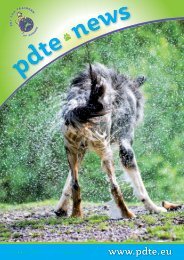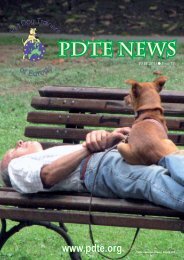PDTE 2013 Winter Newsletter
You also want an ePaper? Increase the reach of your titles
YUMPU automatically turns print PDFs into web optimized ePapers that Google loves.
to inhibit a behaviour can also have<br />
similar effect. Shaking cans for example,<br />
dogs can become habitualised to<br />
sound, because nothing follows it after<br />
a while. It can also lead to aggravation<br />
and annoyance on the part of the dog<br />
causing aggressive reactivity.<br />
WHAT CAN WE DO?<br />
“A CHANGE OF MIND CAN LEAD<br />
TO A CHANGE<br />
OF HEART”<br />
Well, it takes a lot of self-control! Creating<br />
a self awareness and recognising<br />
signs that you are becoming angry and<br />
frustrated early.<br />
Vocal language is also complemented<br />
by body language. We need to be<br />
aware of how we feel and how we<br />
behave. What is the image of a human<br />
in the eyes of a dog? My solution for<br />
people who have developed shouting<br />
habits with their dogs is teaching<br />
clients to communicate with dogs by<br />
using sound and signal. New commands<br />
will eventually be shouted if a<br />
habit of shouting is in place. That must<br />
stop for progress to take place.<br />
Reassuring the dog that all is okay (dog<br />
may anticipate punishment from previous<br />
experience in similar situations).<br />
If you are changing do not expect the<br />
dog to adapt straight away, an association<br />
has been made so you must be<br />
consistent with your change to see a<br />
change in the dog. It may still find you<br />
unpredictable. Re-establishing trust is<br />
your primary goal here.<br />
A question for clients - How does<br />
what I do affect the relationship<br />
with my dog?<br />
HOW CAN WE HELP PEOPLE OVER-<br />
COME HABITUAL SHOUTING?<br />
We need to help calm the conflict<br />
by helping clients to understand why<br />
their dog is behaving in a particular<br />
way. The importance of reading language<br />
correctly-i.e it means this-but it<br />
could also mean that?<br />
Educating the public-what is a dog?<br />
There is a severe lack of understanding<br />
and knowledge or direction through<br />
dangerous assumptions if dog behaviour<br />
of pet owners is leading to social<br />
problem behaviours and bites.<br />
What are they saying? What do they<br />
need? What upsets them? Do you<br />
know what you are living with? Changing<br />
the client’s attitudes and habits<br />
and conquering their desire to shout.<br />
HOW DOGS RESPOND TO POSITIVE<br />
CHANGE<br />
So how can we help clients change?<br />
Empowerment through positive<br />
results, observing dogs more confident<br />
and positive behaviour changes.<br />
Observing and record keeping are<br />
important in order for results and progress.<br />
Record keeping and reflection<br />
are good for the brain, they help keep<br />
you online with the task and make you<br />
more aware of self change.<br />
Honing observation skills and getting<br />
to know your dog. Interpreting the<br />
reaction of a dog gives you ample<br />
knowledge about how the dog is feeling<br />
and so reacting at that particular<br />
time. Its emotional expression for how<br />
it feels in feelings such as fear, happiness,<br />
sadness, avoidance, depression<br />
through trauma, need of love and<br />
companionship.<br />
Much debate has been raised because<br />
human and dog limbic systems are<br />
so similar, but do they also function<br />
similarly? Your answer lies in the dog’s<br />
response to a situation. Behaviours are<br />
progressive and early signs of fear and<br />
anxiety can be observed before allowing<br />
the behaviour to escalate.<br />
A two way debate on whether dogs<br />
have emotions. Some say that dogs do<br />
not have the same feelings as humans,<br />
their brains are not as complex and<br />
they do not have emotion as such...<br />
and some others don’t quite agree.....<br />
Emotions in humans are experienced<br />
in the limbic system of the brain,<br />
which is one of the most primitive<br />
parts of the human brain and which is<br />
present in some form in all mammals.<br />
You will also ‘feel’ the situation. Emotions<br />
create a presence, an atmosphere,<br />
our senses both human and<br />
canine become highly tuned to this.<br />
Interpretation of the dog’s behaviour<br />
will trigger your own response relative<br />
to the information you have gathered<br />
from observation and feeling. This is<br />
normally a very reliable source and is<br />
where your gut instinct comes from,<br />
and this has an influence on your<br />
subconscious to make a decision for<br />
the best reaction to help the dog. It’s<br />
that reliable feeling that enables you<br />
to react correctly and make the right<br />
choices.<br />
It is my belief that dogs do have a<br />
limbic system that works identically to<br />
the human limbic system with respect<br />
to controlling emotions. Dogs are<br />
much, much more than what you see is<br />
what you get and if we are to advance<br />
further we need to appreciate this and<br />
help our clients see that.<br />
28

















